NSWRFS to Conduct internal Review Into Oxford Falls HR: lower your fire risk with a Bush fire survival plan this bushfire season
The NSW RFS will conduct a After Action Review and a formal internal review will be conducted to assess if any improvements can be made to avoid such occurrences in the future following the hazard reduction at Oxford Falls of September 21.
An AAR is similar to debrief and involves describing what was intended, what actually happened, what mistakes were made and how participation may be improved in the future.
A similar process was undertaken following the October 17 2020 North Head Hazard Reduction at Manly when fire jumped containment lines and prompted the evacuation of nearby residents. Driven by stronger winds than forecast, that also arrived much earlier than advice predicted, an additional 54 hectares was burnt than was planned.
As part of the contingency plan undertaken by Fire and Rescue NSW and the NSW National Parks and Wildlife Service for hazard reduction burns, there were approximately 100 firefighters on hand to manage this burn, with support from 3 helicopters for aerial observation and with water bucketing capability.
However, the uncontrolled intense fire moved rapidly across the headland, burning through approximately 62 hectares when 8.7ha was planned, causing the loss of recently reintroduced locally extinct species such as the Brown Antechinus, the Eastern Pygmy Possum and the native Bush Rat, and devastating a substantial proportion of the critically endangered Eastern Suburbs Banksia Scrub at this site, resulting in the abandonment of experimental work being undertaken to support its recovery by the Australian Wildlife Conservancy, which had earlier that year celebrated a decade of an effective conservation partnership at North Head.
Although AWC moved immediately into mitigation processes, rescuing wildlife, installing refuge tunnels, nest boxes and watering points and providing supplementary food for surviving animals. Taronga Zoo vets treated injured wildlife at their clinic, and AWC also worked with National Parks and Wildlife Service and Sydney Harbour Federation Trust during this stage of the response. AWC then monitored for feral predators on a daily basis in this exposed environment as it was crucial they stop feral cat and fox incursions.
North Head is also one of the two remaining sites along the Manly to Barrenjoey peninsula where the Long-nosed Bandicoot may still be found. This population of furry snufflers is classified as an 'endangered population'. The main threats to the Long-nosed Bandicoot population at North Head Sanctuary are road kill, predation by foxes, dogs and cats, and loss of habitat.
.png?timestamp=1728137957220)
AWC’s team installed refuge tunnels to connect patches of unburnt vegetation and provide shelter for surviving animals. Photo: ©Rhiannon Khoury/AWC

AWC had reintroduced three locally extinct species to North Head, including Eastern Pygmy Possum. Rescue efforts we underway to find surviving animals. © Joey Clarke/AWC
Some solace came on July 21 the following year when AWC shared it had recorded new individuals and pouch young among reintroduced mammal species, and come face-to-face with four elusive Brown Antechinus.
''The new mammals and pouch young are positive signs that wildlife is continuing to recover at the sanctuary, nine months on from a hazard reduction burn that jumped containment lines.'' AWC said
''Since the fire, our team of ecologists have been closely monitoring wildlife populations and working to support ecosystem recovery.
''During the recent biannual mammal survey, 17 new Long-nosed Bandicoots were processed as well as 12 Eastern Pygmy Possums (five new individuals, two previously caught adults and five pouch young). One of the Eastern Pygmy Possums was previously captured in March with young at foot and only two months later she was recaptured with two new young ones in her pouch. ''
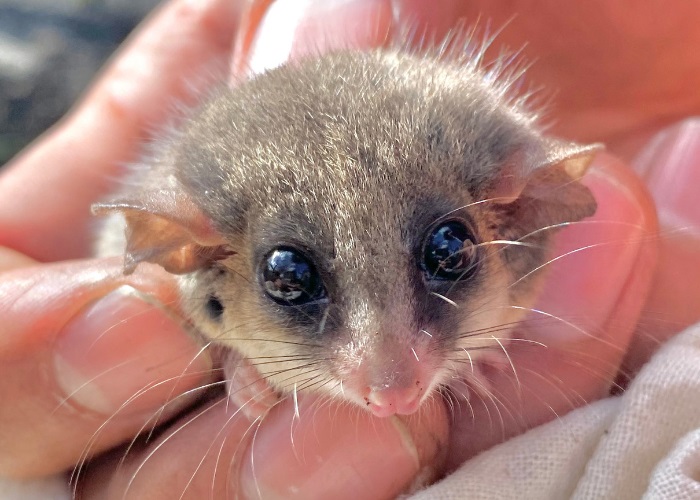
Five pouch young Eastern Pygmy Possums were recorded during May’s small mammal survey. This is a positive sign that the population is growing post fire. Photo: H Nelson/AWC
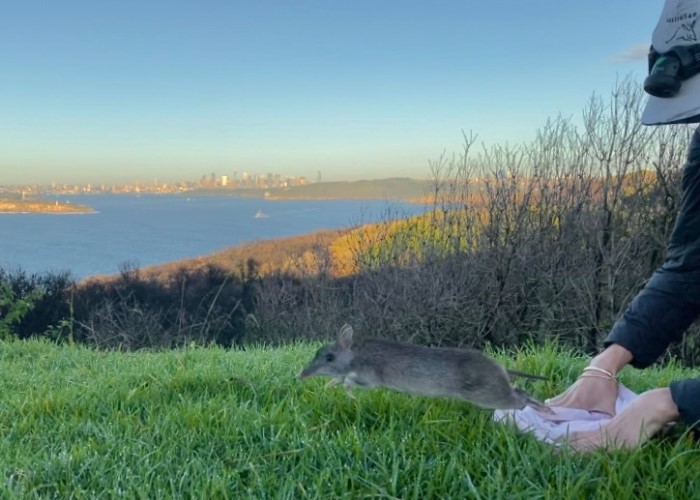
One of 17 Long-nosed Bandicoots processed during the AWC 2021 survey leaps back onto North Head Sanctuary. Photo: H Nelson/AWC
''During the survey, the team also captured and processed four new Brown Antechinus – the highest number of live captures since the species was reintroduced. Two individuals were also detected in nest boxes during a survey earlier this year. Brown Antechinus had previously proved difficult to capture. The occurrence of these individuals in traps is likely due to an increased number of nest boxes that are now deployed across the headland as well as changes in habitat and food availability after the fire.'
“It was really exciting to pick up four Brown Antechinus. We know that they’re out there, thanks to sporadic camera sightings, but we haven’t caught one in a trap for a long time” explains Viyanna Leo, AWC Wildlife Ecologist. “We believe they may be appearing more frequently as they are seeking refuge within our survey areas due to loss of habitat from the fire.”
The 'Meatworks' Hazard Reduction, intended to be close to 24 hectares in size, escaped containment, spread rapidly south-east to Cromer Heights and a much larger area. The HR had rapidly blackened 147 hectares by September 23 when it was successfully contained once more (Source: Fires Near Me).
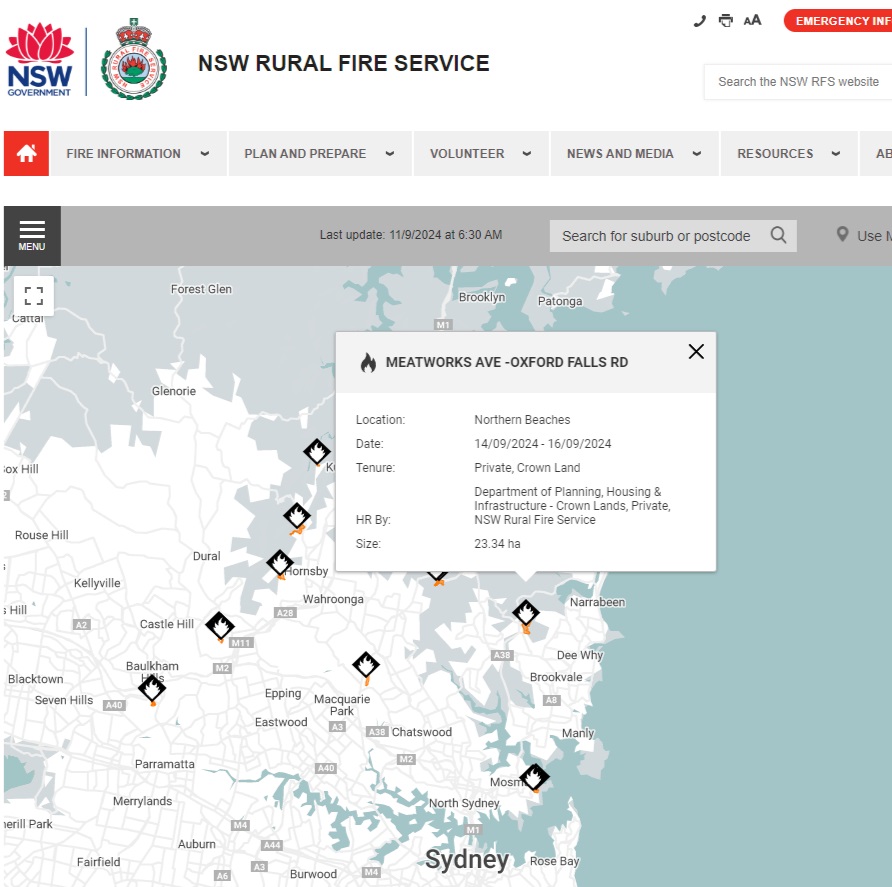
The initial Notice posted by Pittwater Online via Facebook on September 11, 2024
A Total Fire Ban had been advised on Thursday, September 19 for the Greater Sydney Region and Illawarra/Shoalhaven areas.
One local NSWRFS Brigade had advised September 17;
'If weather conditions become unfavourable on the scheduled burn day, the hazard reduction burn will be postponed until conditions become suitable.
Thank you for your understanding as we work to mitigate fire risk before our season starts.'
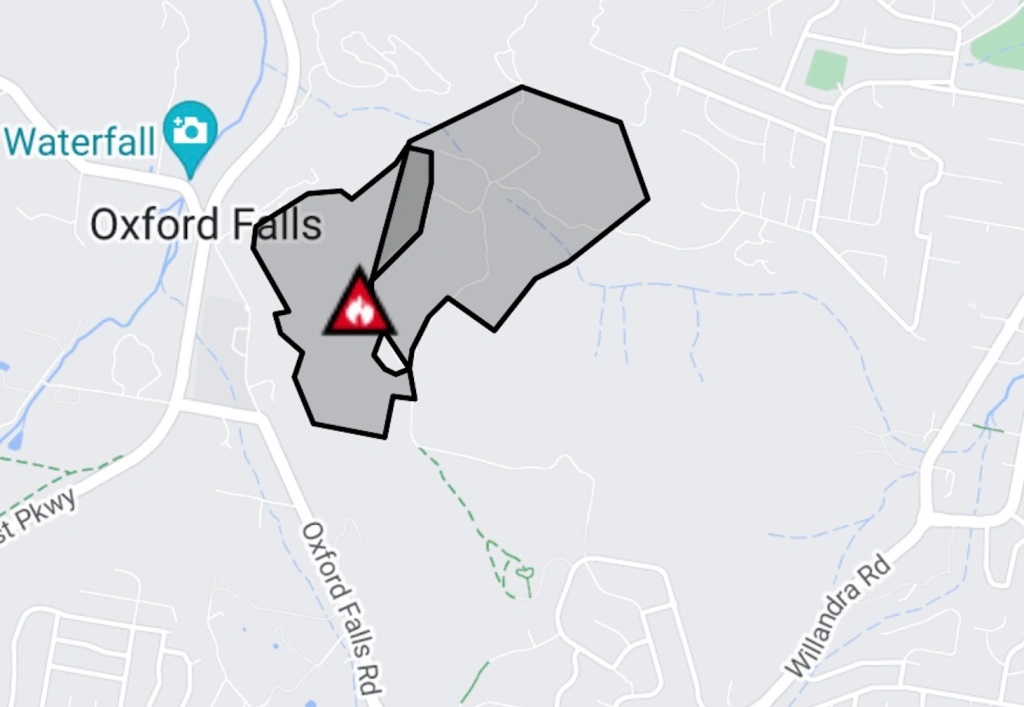
Early stages of the breakout of the Oxford Falls HR, September 21 2024 (Source: Fires Near Me)
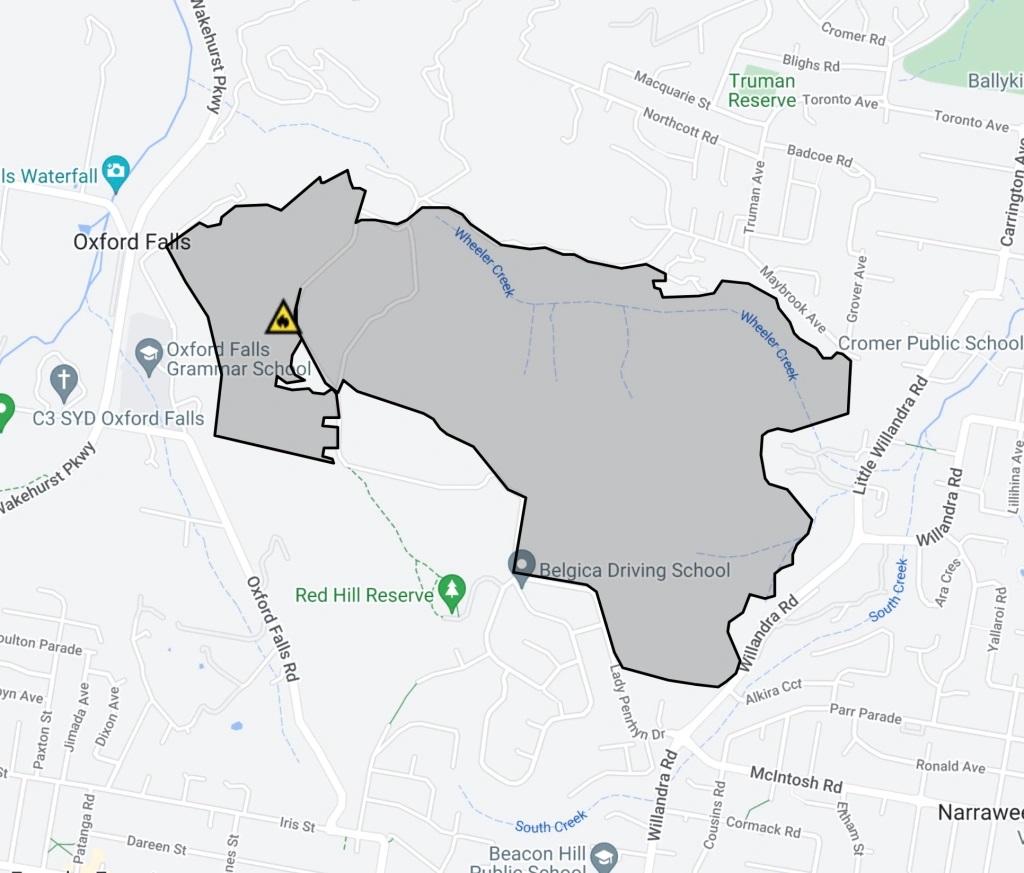
Later stage of the Oxford Falls breakout, 21 September 2024 (Source: Fires Near Me)
Just as had happened at North Head, people were asking that same day, Saturday September 21, and afterwards why this HR was commenced when warm winds had been blowing fast, hard and with sudden blasting gusts in the days leading into it and at dawn on the day scheduled for the burn.
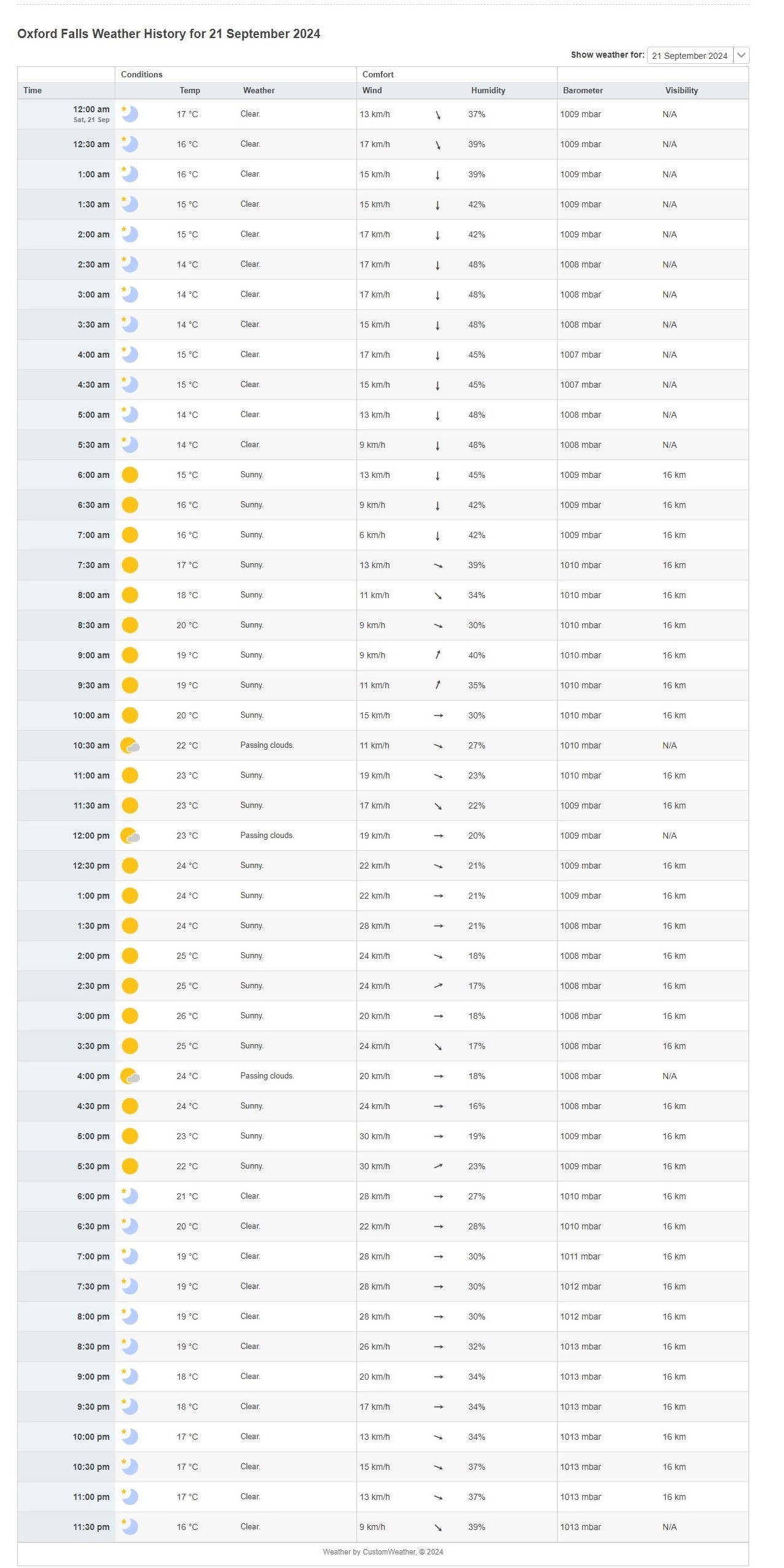
Oxford Falls Weather Station: September 21, 2024 recorded data
The fire and the smoke generated was visible from many parts of Sydney, and provoked lots of commentary from locals, residents across the state and professionals working in the same field, along with many volunteer firefighters expressing dismay and anger on the Rural Fire Service Facebook page at what had occurred.
One respondent, with an Australian Fire Service Medal (AFSM) posted:
'When weather forecasts on that day, indicated possibly high to extreme fire conditions were possible, with South-west to Westerly Winds forecast, undergrowth was at a high cured level to extent where scorching to canopy (wild fire conditions could eventuate).and did. In my RFS training within Australia and internationally I was taught to always observe such prevailing conditions. Why is the science and technology available being ignored?'
Another, one of several across all social media platforms with the same mien:
'What an absolutely devastating and catastrophic mistake by the RFS conducting a hazard reduction in those conditions. No apology or accountability for the irreversible destruction caused to the bushland and wildlife either.'
Wildlife carers and rescuers, who have worked with the NSWRFS in prior HR's were asking:
'Thank you RFS for your hard work. It’s very unfortunate that this happened but thankful it was caught before anything more horrendous happened. How was the impact on wildlife managed? Was there a plan for this?'
Northern Beaches Rural Fire District posted via FB:
September 22, 2024: ADVICE: Meatworks Fire.
Firefighters, working overnight have completed backburns behind properties in the vicinity of Lady Penrhyn Drive, Willandra Drive, Maybrook Ave and Pinduro Place.
Today firefighters will focus their efforts on the western edge of the fire in the vicinity of Red Hill Reserve in order to contain the fire.
Crews will continue to strengthen containment around the fire and they will be supported by waterbombing aircraft.
And by evening of that day:
September 22 2024; 19;37 pm
We want to take a moment to sincerely acknowledge the concerns raised around the recent hazard reduction burn that unfortunately spread beyond the planned control lines. This area, which hasn’t been burnt since 1994, had high fuel loads that contributed to the unpredictable fire behaviour.
Despite our careful planning, a few embers escaped and led to a spread that no one wanted to see. Even today, under calmer conditions, our dedicated firefighters are still working to manage spot fires beyond the control lines.
While the fire’s spread was disappointing, we are thankful that the 140ha area now has reduced fuel loads, with no loss or damage to properties. Had this occurred in the peak of summer under hot, dry, and windy conditions, the outcome would have been far worse.
We are deeply grateful to our incredible volunteer crews, who will remain on site to ensure the fire is fully contained. These same volunteers will be on the front lines this summer, working tirelessly to protect your homes and businesses from bushfires.
The Oxford Falls HR occurred over Get Ready Weekend, September 21-22.
An Independent Bushfire Group (IBG) opinion article related to this event was published in the Sydney Morning Herald online on September 25 ‘Hazard reduction shouldn’t be hazardous. So why the escaped fire at Oxford Falls?’, authored by Ian Brown OAM, BA (Earth Sciences), National Fire Medal.
While the SMH article includes some IBG comment, IBG has written about many of those issues before, much of it freely availably on the IBG website.
After the SMH Opinion Piece IBG shared:
Planned burns are a complex management task, with many risk factors and opportunities to go wrong. All risk factors need to be considered for each burn, but not all risks can be controlled.
Planned burns (both prescribed burns for hazard reduction and backburns for controlling wildfires) have escaped in the past and more will escape in the future. IBG members have themselves lost burns in their firefighting careers. In 2020 a burn by Fire and Rescue NSW and the National Parks and Wildlife Service escaped prominently at North Head. The important thing is not to assign blame but to analyse why these events happen and identify and act upon the lessons learned.
Past experience and analysis has shown that firefighting agencies have insufficient commitment and capacity to properly examine and learn from negative outcomes. And the same applies to good outcomes, where it is just as important to learn how these were achieved. Identifying lessons is not enough; lessons must be documented, promulgated to firefighters and built into practice. There is a vast literature with guidelines and policies on lessons management, but they are insufficiently applied.
Whilst an After Action Review (involving those involved) of the Meatworks incident is a welcome commitment, it should have been routine and has to be well managed, while the internal review is also welcome but inadequate. Any agency investigating itself has a conflicted and impossible task. This is not the best way to produce a report that will be seen by the community as thorough and objective.
Some may say that backburning (which requires much the same planning and skills as prescribed burning) has been well examined, and point to the 2020 NSW Bushfire Inquiry and the 2024 NSW Bushfires Coronials. But this is incorrect. The inquiry did not look at any backburns in detail. The coronials examined only a few, and left many questions about those few unanswered. Most backburns from the 2019-2020 bushfires remain unexamined, whether successful or otherwise.
Expert research on backburn and prescribed burn escapes has to date been minimal, and it is essential that more happens to provide better guidance to firefighters. A project being run by the new NSW Bushfire and Natural Hazards Research Centre (see IBG post of July 24) should help to fill this gap, but it comes nearly five years after the 2019-2020 fires which provide such a strong evidence base. The project “Evaluating backburning and fire-break operations” will take two years and $200,000. Such evaluation needs to be ongoing.
Reviews, inquiries and research should be routine, expert and independent. These are some of the reasons the IBG has been pushing for an Inspector General of Emergency Management for NSW. This is the only way to ensure the right lessons are learned and acted upon for continuous improvement, while also reducing controversy and the ongoing cycle of one-off and inadequate reviews.
Review bodies for many other public safety industries have shown the way. Police, health, the military, even the intelligence services, have independent oversight bodies. They should be welcomed by agencies and government as a positive boon to continuous improvement, safety for all and transparency.
Burning for hazard reduction is another very complex issue (see IBG post of 21 July: “Shortfall in planned burning”). Public and media understanding of the costs, benefits, challenges and technicalities is often poor. Fuel reduction can be useful, especially close to assets and to strengthen natural fire barriers. But, as several RFS Commissioners have said, burning is no panacea. Burning is a useful tool when used well, and partly a numbers game. That is, each effective burn will offer some assistance and protection to a limited area for a limited time, but only if a wildfire threatens within that period.
IBG does not support area-based ‘targets’ because the focus on strategic burning for specific benefits can be replaced with a focus on hectares burnt. ‘Properties protected’ targets are better, but still somewhat fraught. As pressure to burn increases, and as burns perhaps are pushed into more marginal opportunities, the community needs to understand that escapes may become more likely, with increased risk of impacts.
Educative and constructive public discussion is essential to optimise the use of limited burning resources (and weather windows to do burns) and also to maintain some kind of consensus within the community. IBG will continue to contribute to this discussion.
The Independent Bushfire Group is a voluntary NSW collaboration of non-aligned bushfire practitioners, fire managers, land managers, fire researchers and ecologists. The Group’s experience covers every aspect of bushfire, from working on the end of a rake-hoe to organisational leadership, and includes lighting planned fires and putting out wildfires, Incident Controller for emergency fires (‘section 44’ in NSW), measuring fuel moisture levels, studying fire behaviour, planning village fire protection, community fire education, analysing fires and assessing their ecological impacts. With a practical focus and more than 450 years of collective experience across a range of fire landscapes in NSW, Victoria, Tasmania and WA, we promote better bushfire management in the face of climate change.
Pittwater is known for its huge team of active volunteers, especially those who give up their time and energy to serve as members of the NSW RFS.Without these members, who work year round to serve the community, those who faced danger far from here during the 2019/2020 fires would certainly have experienced the loss of property and perhaps the deaths of loved ones.
Nearly three billion animals – mammals, reptiles, birds, and frogs – were killed or displaced by Australia's 2019-20 bushfires. Billions more animals may have been lost had these people not left their families and homes to attend fire scenes in the north of NSW and south of NSW from July 2019 to the end of January 2020 onwards, when the rains came after prolonged drought. (Source: Australia's 2029-2020 Bushfires: The Wildlife Toll)
These teams of people are so good at what they do as volunteers they are deployed year after year to assist firefighters fighting increasingly out-of-control firestorms overseas. In July and August this year a contingent of 60 from Australia joined New Zealand firies to assist the British Columbia Wildfire Service and 30 more were deployed to Alberta.
The firefighters arrived in Canada as part of a years-long partnership through the Canadian Interagency Forest Fire Centre (CIFFC).
CIFFC is a not-for-profit group operated by Canadian fire management partners and shares resources and mutual aid throughout the nation and internationally using the Canadian Interagency Mutual Aid Resource Sharing (MARS) Agreement — and the Australasian Fire and Emergency Service Authorities Council during wildfire seasons.
“The relationship between the B.C. Wildfire Service and Australia is longstanding, with over 15 years of mutual aid, support, and knowledge transfer,” the B.C.W.S. said in July. “The first instances of support started during the 2007 wildfire season in Australia, when B.C. assisted by sending more than 60 personnel to support fire suppression efforts.”
Australian volunteer firefighters fought Canadian fires last year too.
Australian volunteer firefighters have been deployed to America this year again as well - 66 flew to the NIFC's base in Boise, Idaho in our Winter.
The Americans are amazed so many of our firefighters are unpaid volunteers who use up their leave to serve others - even those far from home who they may never know, never meet.
For Aussies it's a case of not waiting to be saved but deciding we'll save ourselves.
So many of us have a lived experience of firestorms, we've grown up knowing we have to be prepared; we know to clean out gutters of leaf refuse as the first days of Spring arrive, clear anything burnable from around the home, get the whole family involved in a Bush Fire Survival Plan.
The 1967 Tasmanian Black Tuesday fires saw 62 people lose their lives, 900 were injured, and 7,000 left homeless.
I survived because my mother, pregnant with my second youngest brother, had prepared our home and grounds and had a neighbour who stood and hosed the house down, incessantly. Dad, who'd left work and raced home to save mum, a 19 months-year-old me, my older 3 and a half-year old brother, was prevented from coming back into the street by a blockade installed on the road by those fighting the fires. They didn't want any more loss of life.
South Hobart was ripped apart - only a few houses still stood after the firestorm came through on February 7 1967. Grant came early, February 20, 1967.
I dreamed of it for years afterwards; especially the black air in the smoke filled house, the roaring sound outside the walls, and mum, her face so white with worry she was luminous, but calm, determined. It's one of my earliest memories.
Even now we remember that just because you can survive a firestorm it doesn't mean you will - nothing can stop a firestorm - but with a wind change, a temperature drop, common sense preparation and vigilance, a bit of luck and a smattering of rain, just might get you through.
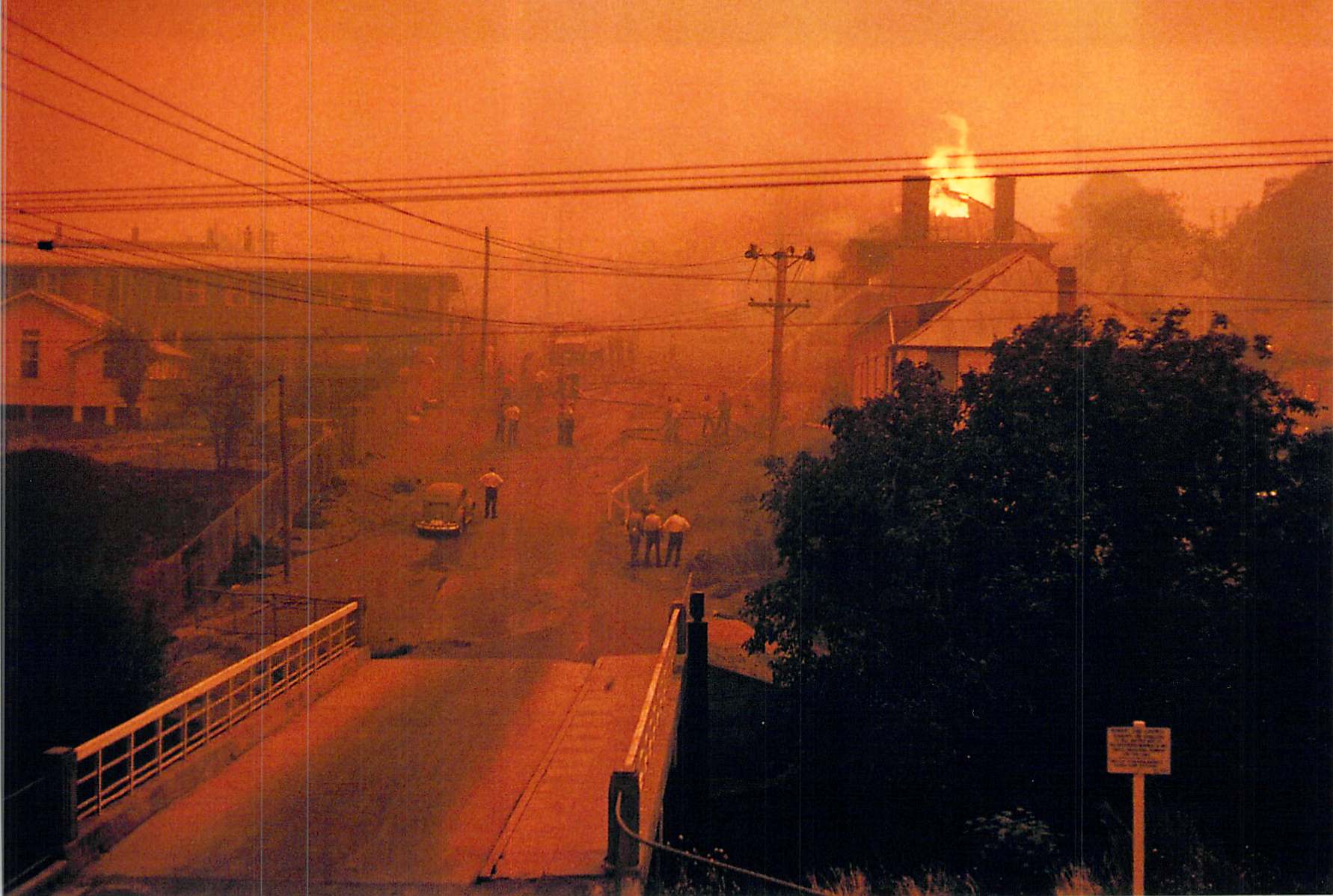
Taken from the intersection of Gore and McKellar streets, South Hobart; possibly other husbands and dad blocked from getting to their wives and children- courtesy Tasmanian Museum and a former fellow south Hobartian.
The Black Saturday fires in Victoria, which began on February 7 2009, with the devastating loss of 173 lives, and 414 injured are the most horrendous in Australian history. More than a million wild and domesticated animals were lost and 450,000 hectares of land were burned, 2029 homes burned to the ground.
The 27 December 1993 to 16 January 1994 Sydney and NSW eastern seaboard bushfires will never be forgotten here - many of us either saw homes exploding in fire at Bayview from across the water (at Newport Hotel for instance), were fighting these fires on Pittwater's western shores, or watched from Palm Beach, waiting for a damp sea breeze to roll in and smoor the blaze before the embers landed - and then someone sang in the rain.
Those fires saw 800,000 hectares burnt in over 800 different, fire-related incidents.
some of the PON/Family newspaper archives collection on the January 1994 fires in Pittwater and Sydney
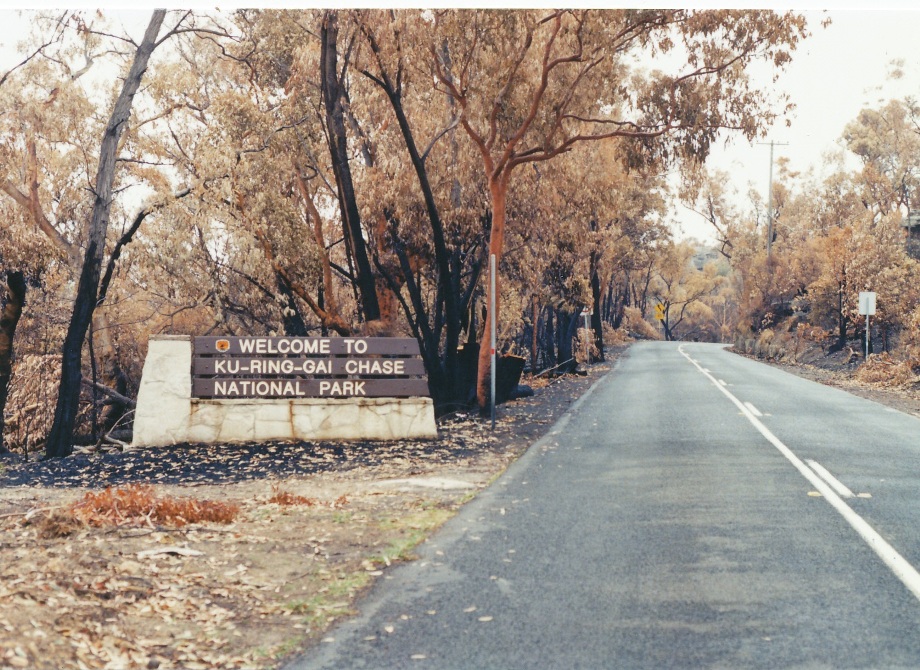
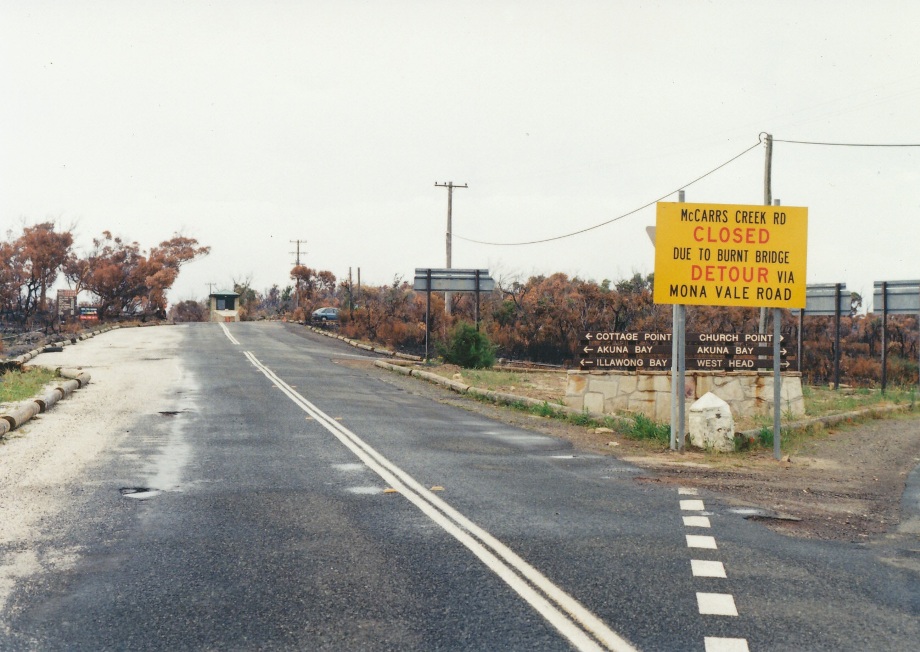
With the loss of 26 loved ones in New South Wales and 34 across the nation, the horrific injuries of those who were caught in firestorms, and which destroyed over 3,000 buildings, including 2,779 homes, in terms of the area of land burnt, an estimated 24.3 million hectares, wildlife deaths, and damage to the environment, some of it permanent, such as the burning of remnant rainforest, the 2019–2020 fires were the worst in Australian history.
The 2019-20 fires burnt over 5 million hectares of New South Wales, including 890,000 hectares of native state forest. On the NSW north coast, over 102,000 hectares of protected old growth in state forests was burnt, with around three quarters of this experiencing full or partial canopy burn.
Australia has around 195,000 volunteers who serve in the six state and two territory bushfire services. The NSW RFS has the largest number:
- Brigades: 1,982
- Local Government Areas: 110
- NSW RFS Districts: 43
- Area Commands: 7
- Headquarters: 1
- Volunteers: 70,829
- Staff : 1,240
This is on par with the over 198,000 members and 315 affiliated Surf Life Saving clubs that Surf Life Saving Australia states represents the largest volunteer movement of its kind in the world. The NSW contingent of surf lifesavers has around 20,000 active volunteer surf lifesavers and 129 clubs across the state, with 78,000 members.
Those 70+ thousand NSW RFS firies are those who come running when the 8400 million others who live in NSW call for help.
In 2022/23, NSW RFS members attended more than 24,000 incidents across the state:
- Bush/grass fires attended by NSW RFS: 6,220
- Structural fires: 1,344
- Motor vehicle fires: 1,881
- Motor vehicle accidents: 5,106
- Assist other agencies: 2,680
- Storm and flood: 135
- Total 24,973
RFS Vision and Purpose:
To provide a world standard of excellence in the provision of a volunteer-based community fire and emergency service.
To protect the community and our environment by minimising the impact of fire and other emergencies.
Values
- — Mutual respect
- — Adaptability and resourcefulness
- — One team, many players, one purpose
- — Integrity and trust
- — Support, friendship, camaraderie
- — Community and environment
- — Knowledge and learning
Stakeholders
- — Community
- — Our members, their families and employers
- — State and Federal Ministers and Members of Parliament
- — Our emergency services and government partners across jurisdictions
- — Peak bodies and organisations representing relevant community, industry, and interest groups
Each late Winter and early Spring we have hazard reductions conducted by Fire and Rescue NSW, the NSW Nationals Parks and Wildlife Service and the NSW Rural Fire Service.
As the IBG shared insights state, these will only offer some assistance and protection to a limited area for a limited time, and only if a fire threatens within that period.
The NSW Government has said the NSW Rural Fire Service (RFS) is prepared for predicted conditions, with firefighters having responded to more than 1,600 bush and grass fires across the state since 1 July.
Minister for Emergency Services Jihad Dib joined Commissioner of the RFS Rob Rogers for a helicopter flight to survey some of Sydney’s most at-risk suburbs on September 30.
Taking off from Arcadia Rural Fire Brigade station, the Minister and Commissioner inspected recent hazard reduction work undertaken in the Hornsby area, as fire agencies and land managers continue work to reduce fuel loads for the warm months ahead.
The NSW Government stated on Monday September 30 it has funded 100 additional hazard reduction crew members to conduct this work.
RFS firefighters train and prepare year-round to respond to fire and other emergency incidents and with most of NSW now in the Bush Fire Danger Period (BFDP), it is important that the community prepares as well.
With the commencement of the official Bushfire Season on October 1 residents are encouraged to take simple steps to lower their fire risk, including:
- Trim overhanging trees and shrubs.
- Mow grass and remove the cuttings and have a cleared area around your home.
- Remove material that can burn around your home, such as door mats, wood piles, mulch and flammable liquids.
- Clear and remove all debris and leaves from gutters surrounding your home.
- Prepare a sturdy hose or hoses that will reach around your home.
While some areas have already entered the Bush Fire Danger Period, the statutory bush fire season runs from 1 October 2024 to 31 March 2025.
Bush Fire Survival Plans and information on preparing your property and family are available on the RFS website at www.rfs.nsw.gov.au.
Residents can stay up to date on fires in their area using the RFS website, the Hazards Near Me app, listening to your local radio station, or by calling the RFS Bush Fire Information Line on 1800 679 737.
Minister for Emergency Services Jihad Dib said:
“We have already seen dangerous fire conditions in NSW, with recent hot, dry and windy weather rapidly drying out bush and grass land areas, increasing the fire risk.
“With high temperatures forecast this Summer, we cannot be complacent. Everyone needs to take the time now to make sure they understand their risk, discuss their Bush Fire Survival Plan with their family and download the Hazards Near Me app.”
“I thank all our RFS volunteers and emergency service personnel for their work to protect communities across the state and encourage residents and landowners to do their part to prepare themselves, their families and properties.”
Commissioner of the RFS Rob Rogers said:
“Consecutive years of wet weather have fuelled growth of vegetation like grass lands, particularly west of the Great Dividing Range. Grass fires can be especially dangerous because they start quickly and spread rapidly, destroying homes and stock.”
“Our firefighters are out on the ground doing everything they can to mitigate the risk of fire, but preparation is a shared responsibility, and we need property owners to do their part, too.
“There can never be a fire truck outside every home, so people need to have a plan in place if threatened by fire. Make sure your whole family knows whether you will stay and defend your home or will leave early - and if so, where you will go.”
Fire and Rescue NSW Acting Commissioner Paul McGuiggan said:
“If you’re planning to travel, especially over the holiday period, be aware of the risk of fast-moving grass fires.
“Before you leave, check the weather forecast and fire danger ratings for that area and have a plan to leave should a grass or bush fire take hold.”
NSW National Parks and Wildlife Service Executive Director Park Operations Coastal Naomi Stephens said:
“NPWS is working hard to prepare for the upcoming bushfire season. We are slashing and mowing areas of highest risk next to houses and other property and ensuring that our fire trails are cleared and available for firefighters in the event of bushfire.”
“Our trained firefighters are carrying out hazard reduction burning, where and when conditions allow, to reduce the risk and are ready to respond to bushfires to protect the community and the parks.”
What went wrong at Oxford Falls in September 2024 and what went wrong at North Head in October 2020 may well turn out to be too little time to get HR's done in opportune conditions and too much pressure to get them done anyway.
However, for those unable or unwilling to fill their boots, give up their own time, money, and self to help others as a volunteer firefighter or as a volunteer wildlife rescuer during or after HR's, ask yourself where you, Australia and NSW would be without these thousands of unpaid workers.
And please - get prepared for what may turn out to be another challenging Summer.